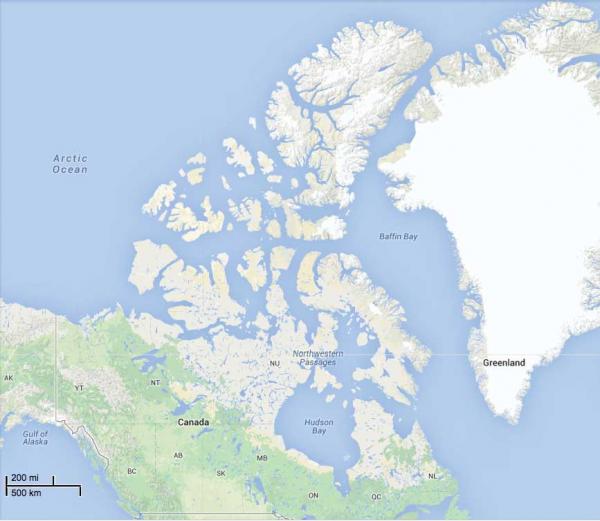
A faded, wind-torn Danish flag is mounted on the wall in the Danish Ministry of Foreign Affairs. Raised on Hans Island by Danish troops, the flag was later taken down by Canadian soldiers — and mailed back to Copenhagen.
Hans Island is a barren islet, just one kilometre in diameter, located halfway between Ellesmere Island and northwest Greenland. It was not until 1973, when Danish and Canadian diplomats were drawing a 2,685 km-long maritime boundary, that they became aware of a difference of opinion concerning title over the island. Instead of delaying their negotiations with this development, the negotiators simply drew the boundary line up to the low-water mark on one side of the island, and continued it from the low-water mark on the other.
The diplomats might have envisaged a quick resolution, given that Hans Island is smaller than some of the icebergs that drift past it. But four decades later, Hans Island is the only disputed land in the entire circumpolar Arctic. All the other Arctic sovereignty disputes concern the maritime domain: a boundary in the Beaufort Sea; the extent of Canada and Russia’s jurisdictions over the Northwest Passage and the Northern Sea Route, respectively; and the possibility of overlapping continental shelves in the Central Arctic Ocean. By comparison, Hans Island is small potatoes indeed, which offers some interesting opportunities – to divide the island in half, share sovereignty over it, or even accept a potential Inuit claim.
Denmark’s claim to Hans Island is based on its discovery in 1853 by an expedition that included the Greenlander Hans Hendrik of Fiskenæsset, after whom the island is named. Denmark’s claim also relies on the historic use of the island by Greenlandic Inuit as a vantage point when hunting.
Canada’s claim is based on the transfer of North America’s High Arctic islands from Britain in 1880. The claim also relies on the international legal requirement that title to territory be maintained by regular activity, which Canada has done, to some degree. For example, Hans Island was briefly home to a Canadian scientific base during the Second World War. Later, in 1953, Eric Fry of the Topographical Survey of Canada surveyed Hans Island and built a cairn, in which he left a note claiming the island for Canada.

Since the dispute emerged, Denmark and Canada have engaged in some expensive forms of posturing, including the deployment of military aircraft and ships. In 1984, the Danish minister for Greenland flew to Hans Island and planted a Danish flag. The Canadian government issued a diplomatic protest. Additional Danish flag plants — and Canadian protests — followed in 1988, 1995, 2002, 2003 and 2004.
Both sides have maintained a sense of humour throughout. As a Danish diplomat wryly observed, “When Danish military go there, they leave a bottle of schnapps. And when [Canadian] military forces come there, they leave a bottle of Canadian Club and a sign saying, “Welcome to Canada.”
In Canada, the dispute only began attracting public attention in 2002, after an article entitled “The Return of the Vikings” was published in the Globe and Mail. The previous summer, the Danish frigate Vædderen had landed sailors on Hans Island. The island was devoid of other visitors at the time, and the Canadian government responded with the standard diplomatic protest. But in the article, the Danes were described as “invading hordes” — a curious choice of words for close NATO allies.
The sensationalized report played directly into the hands of politicians, who were happy to take advantage of a risk-free Arctic sovereignty dispute for domestic electoral purposes. Indeed, the Vædderen had sailed to Hans Island just a couple of months before the Danish general election of November 2001. Canada’s most dramatic response — a flag plant in July 2005, accompanied by a visit from Defence Minister Bill Graham — occurred as Paul Martin’s minority Liberal government was staggering towards defeat.
The role of domestic politics becomes more apparent when one considers that the dispute has no implications for the location of the maritime boundary between Canada and Greenland, or for Canadian or Danish rights elsewhere.
Solving the Hans Island dispute should be as easy as drawing a straight line from the end of the maritime boundary on one side of the island to the continuation of that line on the other. Under this approach, each country would secure title over roughly half the island, and Canada and Denmark would share a short and very remote land border.
Another, more interesting solution would be to declare Hans Island a condominium — an arrangement in which Canada and Denmark would share sovereignty over the island. A number of such arrangements exist elsewhere, including Pheasant Island in the Bidasoa River between France and Spain. Those two countries share sovereignty, with administrative responsibility alternating every six months between the French municipality of Hendaye and the Spanish municipality of Irún.
But whatever the solution, Inuit in Canada and Greenland should be involved in the process. The governments of Greenland and Nunavut might wish to manage the new border or condominium. They might, additionally, wish to create an international park along the lines of Waterton-Glacier International Peace Park, which straddles the Canadian province of Alberta and the US state of Montana.
The Inuit might even wish to claim title over Hans Island themselves. As neither Canada nor Denmark realized the existence of their dispute until 1973, and have since contested each other’s position, it is possible that neither state has perfected its title.
In other words, Hans Island might never have been colonized. And if so, the Inuit arguably retain any pre-existing, pre-colonial rights.
Perhaps this awareness will add a dose of sobriety to the Canadian and Danish positions. Hans Island is a disagreement between friends that could prompt us to think of sovereignty in creative and inclusive ways. Let’s forge a beacon for the world to follow, rather than another excuse for political posturing.
This article is a condensed and edited excerpt from Michael Byers, International Law and the Arctic (Cambridge University Press, 2013).






